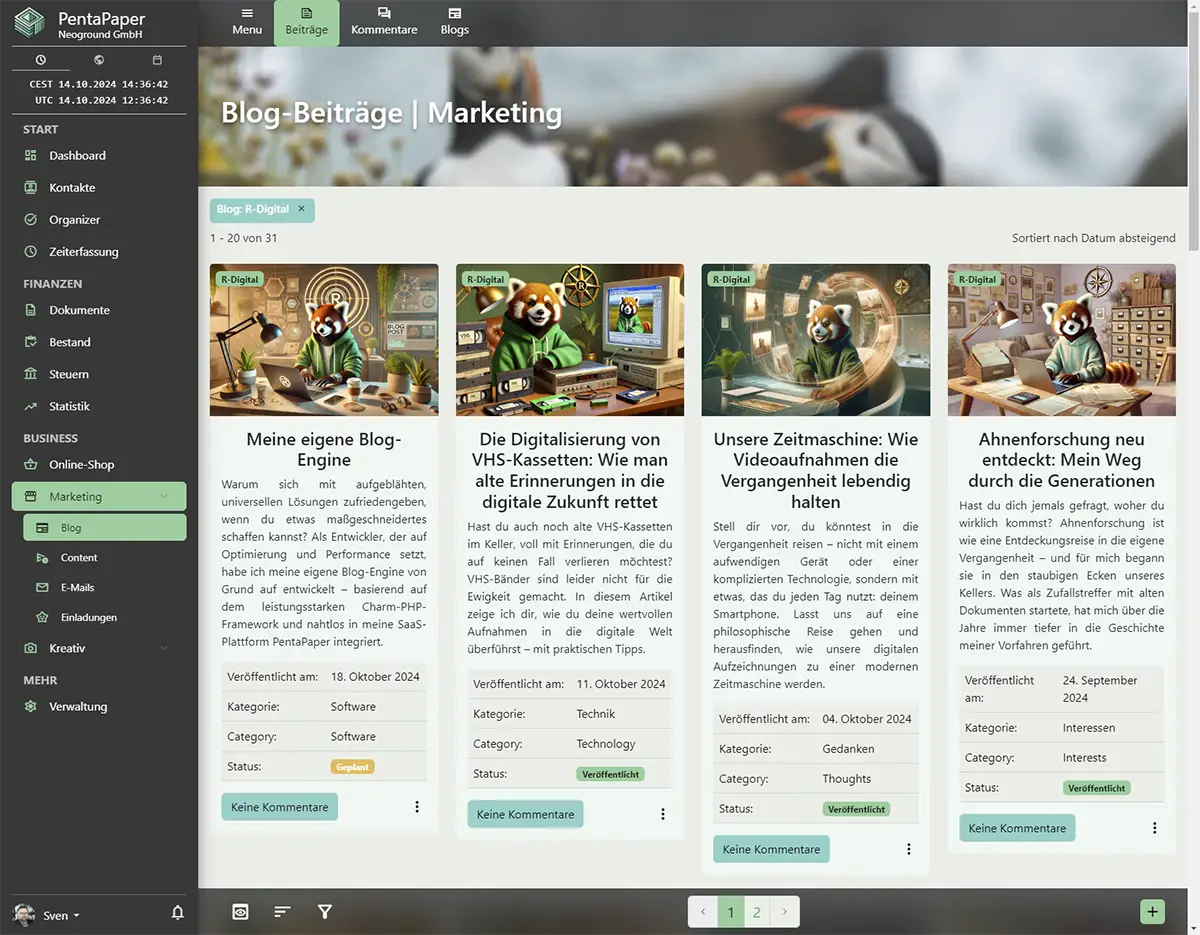The Quest for Simplicity in a Complex Web World
Building websites and managing online content is something that has long been dominated by heavy-duty content management systems (CMS) like WordPress. For most businesses, WordPress is the go-to choice due to its vast plugin ecosystem and easy-to-use interface. But as someone who’s spent years in web development, I quickly discovered that while these CMS solutions are flexible, they’re often unnecessarily bulky for the kind of projects I manage. Especially for simple blogs, CMS platforms like WordPress introduce more complexity than they solve, making sites slow and harder to maintain.
This realization spurred me to take a different approach. As an expert in PHP and web development, I decided to create a custom blog engine that fit perfectly with my needs—lightweight, powerful, and fast. That journey led me to build an entire ecosystem that includes the Markcoon blog system and is based on the Charm PHP framework, and my SaaS platform, PentaPaper.
Let me walk you through how and why I built this unique setup, what makes it special, and why it’s the perfect solution for both my personal and business needs.

Why Standard CMS Platforms Fall Short
When I started looking into options for my personal and corporate blogs, the first question was: Why not WordPress or another popular CMS?
The answer is simple: performance and simplicity. CMS platforms like WordPress are designed to be incredibly versatile, which is a double-edged sword. They come packed with features, but those features introduce significant overhead. Here’s why they didn’t work for me:
- Bloated features: Most CMS platforms are built to handle everything from blogs to e-commerce sites, meaning they come loaded with features I didn’t need.
- Performance issues: All that extra functionality means more code to run, making sites slower, especially as the site grows.
- Security: The sheer popularity of CMS platforms also makes them frequent targets for hackers, requiring constant updates and patches.
For me, this didn’t cut it. I needed a system that was fast, scalable, and—most importantly—tailored to the way I work. That’s when I decided to take control of the entire stack and build it from scratch.

Markcoon: A Lightweight Flat File Blog System
The first piece of the puzzle was Markcoon—my own flat file markdown blog system. Markcoon is built on top of the Charm PHP framework (which we’ll dive into shortly) and uses markdown files with frontmatter for storing blog content. It’s designed for simplicity, so I don’t have to deal with databases for simple posts. Here’s how it works:
- Flat File Structure: Blog posts are stored as markdown files in the
data/blog/postsdirectory. Each post has frontmatter metadata (like the post title, date, and status), which makes managing posts easy without needing a complex database setup. - Asset Management: Each blog post’s assets (such as images and documents) are neatly stored in the
data/blog/assets/$slugfolder, ensuring a clean and organized file structure. - Thumbnails: Blog post thumbnails are stored separately in
data/blog/thumbnails, making it easy to reference them in templates.
Markcoon was initially designed to be a simple static blog engine for my personal website. However, it quickly grew into something more when I integrated it into my broader business ecosystem. I needed a backend system to manage the growing content, so I took Markcoon and transformed it into the current blog engine. The old static blog engine is now open source and can be found on GitHub.

PentaPaper: My Personal Business Hub with a Marketing Twist
PentaPaper is a custom SaaS platform I built for managing every aspect of my business. It handles everything from invoicing and contact management to marketing, expenses, and project tracking and is currently in a closed beta and will be released to the public next year. When I realized that I wanted to manage my blog content alongside my other business tasks, I extended PentaPaper's Marketing module to include a blog management suite.
Here’s what PentaPaper offers and how it fits perfectly into my blogging workflow:
- Local Content Creation: I write blog posts directly in PentaPaper, where I manage my business tasks, my social media marketing and all my business assets. This makes it easy to keep everything centralized—no switching between different apps or platforms.
- Document Management: Besides blogging, PentaPaper helps me create invoices, manage client information, track expenses, and even manage product inventory.
- Blog Publishing Workflow: Posts are created and stored locally in a database. When a post is ready to go live, it can be synced to the appropriate environment (e.g., staging or production) based on the post’s status, such as "beta" or "published."
- REST API: PentaPaper’s backend communicates with my blog via a secure REST API, allowing for seamless integration and real-time updates across all environments without the need of any public backend (so it's a lot more secure).
The result? A streamlined, all-in-one platform that allows me to manage my entire business and blog with incredible efficiency. But this system wouldn’t be nearly as powerful without Charm, the PHP framework that underpins it all.
Oh and it's pretty neat to manage all my content from a single interface, no matter where it will be published.


Charm: The Foundation of My Blog and Beyond
Charm is the real powerhouse behind Markcoon, PentaPaper, and all my other projects and websites. It wasn’t created specifically for blogging or static websites, but rather as a high-performance PHP framework designed to handle complex business applications with ease. Over the years, Charm has evolved, gaining features and optimizations that make it the perfect foundation for almost any project.
Here’s why Charm stands out:
- Blazing-Fast Performance: Charm was built with speed in mind. From its fast router to its integration with Redis (or KeyDB as a drop-in replacement), every aspect of Charm is optimized for performance.
- Modular & Scalable: Charm combines the best elements of popular frameworks like Laravel and Symfony, without the bloat. It uses Eloquent ORM for database operations but gives you the flexibility to customize as needed.
- Built for Business: Charm was created with large, complex applications in mind. That’s why it includes out-of-the-box features like a Cron and Queue system, along with advanced debugging tools like Kint and Whoops.
- Flexibility: While Charm provides its own Twig views, it can also integrate with modern JavaScript frameworks like Preact for dynamic apps, making it versatile for any project.
One of the things I’m most proud of with Charm is how it’s grown alongside me and my business. It’s been the foundation for many commercial projects, making it battle-tested and reliable. Today, it powers not only my blog but many client websites and business applications, showcasing its flexibility and robustness.
Crafting a Bilingual, High-Performance Blog
Another exciting feature of my setup is its bilingual support. As someone who writes in both German and English, it was essential to have a system that could handle content in multiple languages seamlessly. Thanks to some custom AI-driven prompts, I can quickly translate posts, ensuring my content reaches a wider audience without sacrificing quality.
By leveraging PentaPaper and Charm, I’ve built a blog engine that is:
- Fast and Scalable: No unnecessary overhead, optimized for performance.
- Integrated: Blog management is just one part of a larger business system, making it easy to manage everything from a single platform.
- Bilingual: AI-assisted translation makes it quick and easy to maintain posts in multiple languages.
- Dynamic: Whether I’m syncing posts between environments or tracking comments, the REST API ensures everything runs smoothly and securely.
Conclusion: Why Build Your Own When CMS Platforms Exist?
Building my own blog engine wasn’t just about writing code—it was about creating a system that fit exactly what I needed. While CMS platforms like WordPress are fantastic for many, they simply didn’t offer the performance, flexibility, or control I wanted for my blog and business.
With my custom blog engine, PentaPaper, and Charm, I now have a system that:
- Provides complete control over every aspect of my blog and business.
- Delivers blazing-fast performance.
- Grows with my business, thanks to the modular nature of Charm and the extensibility of PentaPaper.
For businesses or developers looking for an alternative to traditional CMS platforms, I invite you to explore the possibilities of crafting your own solutions. With the right tools, you can create a streamlined, powerful system that works perfectly for your needs—no compromises.
Content can easily be managed in the code base in multiple languages thanks to the Charm framework and twig views, with deployment via git and the blogs have a simple backend UI and their API. I'm very happy with the current workflows—managing all my websites and contents are easily done.
Right now this solution is only used on my own projects, but it works pretty well. So I might open source this system in the future as well.
Curious to see how Markcoon and Charm work in practice? Check out the open-source repos on GitHub, or reach out if you’re interested in collaborating on custom web projects. Let’s build something fast, scalable, and tailored to your vision!
This post was created with assistance from AI (GPT-4o). The illustrations were AI-generated and all screenshots were taken by myself. Curious how AI can help create content and images from your own ideas? Learn more at Neoground GmbH.







No comments yet
Add a comment